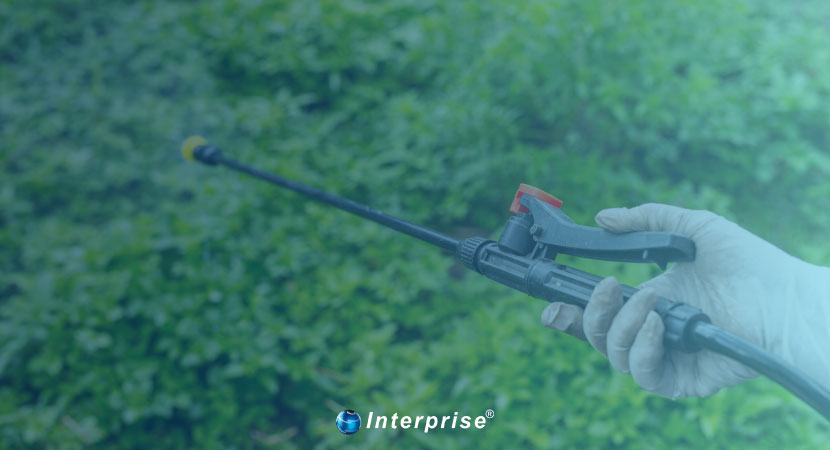
FUNGICIDE USES AND RISKS
Introduction to the Uses and Risks of Fungicide
Fungicides are the first step to prevent and control fungal disease. Fungicides are applied to seeds and plants as a preventative measure to stop and kill fungus before it can infect plants and spread to an entire crop or lawn. While a fungicide is not a cure-all, it can be used as a proactive measure by farmers and homeowners alike to ensure they have a healthy harvest and well-maintained lawn. (1)
What is a Fungicide used for?
Fungicide is used to control fungi like rusts, mildews, scabs, blights, and mold. Used in a range of situations from agriculture to home and garden, the EPA, outlines use cases below (3):
- Protection of seed grain during storage, shipment, and germination
- Protection of mature crops, berries, seedlings, flowers, and grasses in the field, in storage, and during shipment
- Suppression of mildews that attack painted surfaces
- Control of slime in paper pulps
- Protection of carpet and fabrics in the home.
Is Fungicide Safe?
If handled properly, the toxicity of fungicides on humans is generally low. However, if contact is made with eyes or skin, it can cause serious irritation. If a fungicide is inhaled it can also have more serious consequences including throat irritation, sneezing, and coughing. It’s best to avoid repeated exposure over time because even at low doses it can lead to adverse health effects. As a safety measure to prevent unnecessary and unsafe exposure, most fungicides will include a colored dye that shows users what has been treated and what has not.
Is Fungicide Harmful to Plants?
Fungal diseases are easy to misdiagnose, so it’s especially important to make sure you rule out other causes before applying fungicides. For instance, fungal-like organisms including pythium and phytophthora, behave a lot like fungi as they also feed off plant matter and can cause plant disease. However, if you treat the plant with fungicide it can actually do more harm than good if no true fungal disease is present.
When Should you Apply Fungicide?
For fungicide to be effective, it must be sprayed on a plant before a fungal disease appears. That’s because it will create a layer on the plant that will prevent fungal diseases from attaching to the plant. However, it’s best to reapply over time as growth can break down the fungicide making it less effective. Rain can also wash off fungicide over time, so if there is consistent inclimate weather, it’s smart to reapply for good measure. (2)
More about Copper Fungicides
A common organic fungicide, copper fungicides are helpful to withstand heavy rain and inclimate weather. However, they aren’t as useful when plants are growing fast as they can break down and be less effective. It’s best to use this type of fungicide sparingly as it can actually break down plant tissues.
More about Lawn Fungicides
Lawn fungicides are an incredibly common way many homeowners maintain their lawns. At neighborhood hardware stores people can find hundreds of fungicide solutions for their lawn maintenance. The ubiquity of fungicides calls for a greater understanding of how to safely use them.
2,4-D Linked to Serious Disorders
Researchers have linked a common lawn fungicide, 2,4-D weed killer, to a number of serious disorders including non-hodgkin’s lymphoma (a blood cancer), and sarcoma (soft-tissue cancer). Other harmful effects include decreased fertility and increased risk of birth defects. As such, the government has labeled it a potential carcinogen. Despite this, it is still an incredibly common chemical used to control lawns and agriculture.
Chem Service offers analytical standards to test for fungicides.
Chem Service has over 55 years in setting the standard for chemical testing. Skilled in their knowledge of fungicides, Chem Service has an ample selection to help you test for fungicides.
Source
- DOMYOWN Staff. Why You Should Use Fungicides in Your Yard. P&M Solutions LLC DBA MYOWN, 2021. DOMYOWN, https://www.domyown.com/why-you-should-use-fungicides-in-your-yard-a-733.html#:~:text=Fungicides%20are%20used%20to%20control,and%20spreading%20throughout%20the%20lawn.&text=Fungicides%20also%20do%20not%20control,or%20plants%20caused%20by%20insects.
- Purdue College of Agriculture. “Purdue Agriculture.” Youtube, https://www.youtube.com/channel/UCg2oiCiCJP8FShWRvtEf-MQ. Accessed 2021.
- Routt Reigart, J. “Fungicides.” Recognition and Management of Pesticide Poisonings, 5 ed., Diane Publishing Co., 2013, p. 137, https://books.google.com/books?id=cVvUZ8wXPFsC&pg=PA137&lpg=PA137&dq=Protection+of+seed+grain+during+storage,+shipment+and+germination+Protection+of+mature+crops,+berries,+seedlings,+flowers+and+grasses+in+the+field,+in+storage+and+during+shipment+Suppress.